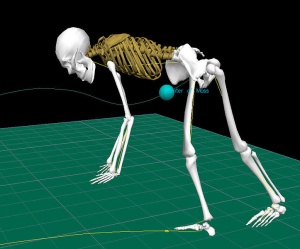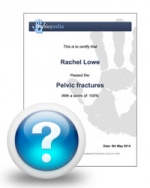Centre of Gravity
Original Editor - The Open Physio project.
Top Contributors - Admin, Sheik Abdul Khadir, Kapil Narale, Rachael Lowe, Laura Ritchie, Kim Jackson, Wanda van Niekerk, Lucinda hampton, Scott Buxton, Simisola Ajeyalemi, Jess Bell, Olajumoke Ogunleye, Tony Lowe, Evan Thomas, Tarina van der Stockt and WikiSysop
Introduction[edit | edit source]
The centre of gravity (COG) of the human body is a hypothetical point around which the force of gravity appears to act. It is point at which the combined mass of the body appears to be concentrated. Because it is a hypothetical point, the COG need not lie within the physical bounds of an object or person. One subjective way (there are objective measures) to approximate the COG of an object is to visualise it balancing on one finger.
Centre of gravity in the human body[edit | edit source]
In the anatomical position, the COG lies approximately anterior to the second sacral vertebra. However, since human beings do not remain fixed in the anatomical position, the precise location of the COG changes constantly with every new position of the body and limbs. The bodily proportions of the individual will also affect the location of the COG.
Stability and the centre of gravity[edit | edit source]
The direction of the force of gravity through the body is downward, towards the centre of the earth and through the COG. This line of gravity is important to understand and visualise when determining a person's ability to successfully maintain Balance. When the line of gravity falls outside the Base of support (BOS), then a reaction is needed in order to stay balanced.
When the line of gravity is within the BOS, an object or person is said to be stable. When the line of gravity falls outside the BOS, the object or person is said to be unstable. Given that the line of gravity must fall within the BOS in order to satisfy the criteria for stability, the following factors should be considered:
- A larger BOS increases stability (the line of gravity must move a greater distance to fall outside the BOS)
- A lower COG increases stability (it's unlikely that the line of gravity will fall outside the BOS)
| [1] | [2] [3] |
Centre of Gravity and Center of Mass [edit | edit source]
Recent Related Research (from Pubmed)[edit | edit source]
Failed to load RSS feed from http://www.ncbi.nlm.nih.gov/entrez/eutils/erss.cgi?rss_guid=12auu1PYsGCIpp67n6cPyeI5nl2WKFZ27pIb3m5fQhGO_33YVW: Error parsing XML for RSS
Read 4 Credit[edit | edit source]
|
Would you like to earn certification to prove your knowledge on this topic? All you need to do is pass the quiz relating to this page in the Physiopedia member area. |
References[edit | edit source]
- ↑ mstateathletics. Physics of Football - Center of Gravity. Available from: http://www.youtube.com/watch?v=2WUdHBso3Vk [last accessed 09/03/13]
- ↑ hplcchmc. Body Center of Mass Example - Motion Analysis. Available from: http://www.youtube.com/watch?v=HSW8gXmOazs [last accessed 09/03/13]
- ↑ Classroom Video. The Body in Motion - Influences on Movement (excerpt) Available from: http://www.youtube.com/watch?v=I_0ApUE18DA [last accessed 09/03/13]
- ↑ Pamela K Levangie, Cynthia C Norkin: Joint Structure and Function: A Comprehensive Analysis: A Comprehensive Analysis (Google eBook):F.A. Davis:2011
- Norkin, C. & Levangie, P. (1992). Joint structure and function. ISBN 0803665776








